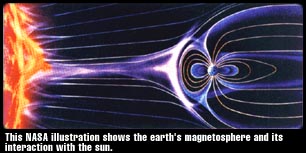|
|
|||||
|
Sun-Earth Connections |
|
||||
| The Sun provides all the Earth's energy. Its light provides energy for photosynthesis in plants
and algae, the basis for the food chain, which ultimately feeds all life on earth. However some solar phenomena,
including sunspots, can affect Earth and humans in other, less benign ways. Seeing (sun) spots Besides possibly affecting our climate, sunspots affect life here on earth in other significant ways. As early as the nineteenth century, scientists noticed that high levels of activity on the sun, like flares and sunspots, were followed shortly by strong fluctuations in electronic instruments on earth, and changes in natural phenomena like the aurora. They wondered what caused these changes. |
 Massive solar explosions Massive solar explosionsScientists today have discovered a lot about what causes these events. According to Dearborn, "The sunspot itself, the dark region on the sun, doesn't by itself affect the earth. However, it is produced by a (solar) magnetic field, and that magnetic field doesn't just stop, it comes to the surface and expands out above the surface...." Hot charged plasma near a sunspot interacts with magnetic fields, and the plasma can burst up and out from the sun, in what is called a solar flare, or in a coronal mass ejection (CME). Energetic particles, x-rays and magnetic fields from these solar events bombard the earth in what are called geomagnetic storms. These storms can affect us in many ways." |
| Auroras Ordinarily, Earth's magnetic field protects human activity from most of the sun's emissions, deflecting particles and fields with its own magnetic pressure. But magnetic storms produce heightened, spectacular displays of the Aurora Borealis and the Aurora Australis, otherwise known as the Northern and Southern Lights, at the poles where the earth's magnetic field lines are concentrated. |
 |
 As
George Fisher describes it, the earth has a protective cocoon
of magnetic field called the magnetosphere, and it normally shields us from the sun's magnetic field, and the other energetic particles of the solar wind.
But during a flare or coronal mass ejection a large cloud of plasma breaks away and hits the earth's magnetosphere, and
disturbs it, and this disturbance shows up as aurora and phenomena in the earth's atmosphere. As
George Fisher describes it, the earth has a protective cocoon
of magnetic field called the magnetosphere, and it normally shields us from the sun's magnetic field, and the other energetic particles of the solar wind.
But during a flare or coronal mass ejection a large cloud of plasma breaks away and hits the earth's magnetosphere, and
disturbs it, and this disturbance shows up as aurora and phenomena in the earth's atmosphere. |
|
|
|||||
|
|
|||||
|
©Copyright 2001 Regents of the University of California. |